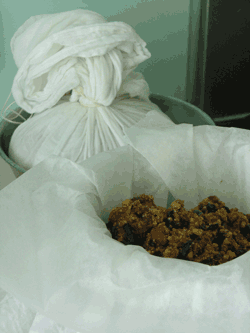the mistress’ own plum pudding




200g/400g seedless raisins
200g/400g sultanas
65g/125g candied peel, finely chopped
65g/125g glacé red cherries
65g/125g glacé ginger, roughly chopped
235g/275g fresh Mejhul dates or 250g/300g soft pitted Chinese dates, cut into 3
120g/250g glacé apricot, cut into quarters
½ /1 granny smith apple peeled and quartered
½ /1 large carrot peeled and roughly chopped
125g/250g suet white part only roughly chopped lightly frozen and finely minced
125g/250g stale white bread
2/4 oranges zest of all, juice of two and a half
½ /1 lemon zest of all, juice of half
125g/250g plain flour
125g/250g soft brown sugar
½ teasp/5g mixed spice
½ teasp/5g cinnamon
¼ /1/2 a nutmeg
3 whole eggs and 1 yolk/7 x 61g eggs or equivalent at room temperature
185ml/375ml Guinness stout or other stout replace with dry ginger ale
50g/100g cognac
Place the raisins, sultanas, candied peel, glacé ginger, cherries, dates and into a large bowl. Add the orange and lemon zest and strain the juice onto the fruit. Grate the nutmeg into the bowl and add the cinnamon and mixed spice. Add the cognac and the stout; mix well, cover with plastic and allow to stand in a cool place for at least five hours or preferably overnight.
Tear up the bread and add the flour and process in the food processor until very fine. With the motor running add the chilled suet and process until you have what resembles very fine breadcrumbs – add to the fruit and mix well. Process the carrot and apple in a food processor until it is fine then add to the fruit mix. Put the eggs into the bowl of your electric mixer with the balloon whisk attached. Whisk until they start to foam, add the sugar and whisk until thick and fluffy. Add to the fruit, mix well cover and allow to rest in a cool place overnight. This can also be refrigerated for a couple of days…basically you need the moisture to be pretty much absorbed by the fruit.
My Grandmother used to lard and flour the pudding cloths and put the pudding straight into the cloth but if this isn’t done fastidiously is can lead to a poor result. I prefer to either cook the puddings in floured and buttered pudding bowls that are then wrapped in cloth and tied up or line a cloth with baking parchment and tie up…the latter being my most often used method because I like the traditional shape and make many varying sizes as Christmas gifts.
The old-fashioned way to cook the puddings was to put about 15cm of water into a large saucepan and put a bread and butter plate upside down on the bottom and boil them, but this is dangerous as it can easily boil dry. I prefer to use a steamer and I set a timer to regularly check the water level. Steam small puddings for two hours, large for four.

Traditionally these British puddings are hung to dry out and mature…I still have one small pudding from last year in perfect nick that has never seen the inside of the freezer. However, I have also seen puddings handled traditionally go mouldy and have to be discarded which is a waste of time and money. My Grandmother Quinn was a tough woman, Polio at a young age and although we knew she suffered, the only time I have ever seen her cry is when we pulled her dozens of puddings destined as Christmas gifts down to see tiny mouldy flecks on their cloths.
For years now we have followed the CWA’s [Country Womens Association] advice and once they have dried and are completely cold put them straight into the freezer.
To serve
If you have frozen your pudding, take it out of the freezer Christmas Eve for a medium pudding and early say on Christmas Eve morning for a large pudding.
It is a good idea to get the pudding steamed before the rush of serving lunch starts. Steam the pudding for two hours and rest in the steamer to keep warm. Carefully unwrap and unmould onto your serving plate. Flame with warmed cognac. Don’t go overboard with the cognac one year we momentarily set fire to the tablecloth!
Traditional condiments are
Brandy butter
Crème Anglaise
Vanilla ice cream
recipes will follow pre Christmas
